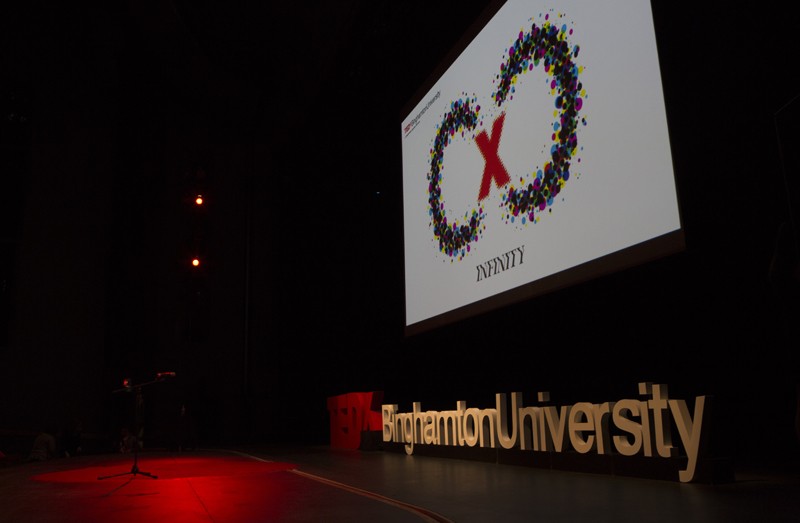TEDx2018: ’Atlantic’ editor unveils formula for popularity
Derek Thompson discusses importance of familiar surprises

Anyone who frequents the movies could tell you that sequels, adaptations and reboots are among the most common films premiered - and they always seem to be the most popular.
Derek Thompson, senior editor at The Atlantic, dedicated his TEDxBinghamtonUniversity2018 talk, titled “The Science of Popularity,” to explaining why.
Speakers came from all over the world to share ideas with the Binghamton community at the Osterhout Concert Theater on March 25. Other non-Binghamton University speakers included Richard Kreipe, medical director for the New York State Department of Health’s Western N.Y. Comprehensive Care Center for Eating Disorders; Guy Laramée, interdisciplinary artist; Andrew Taggart, practical philosopher; Sarah Dudas, biologist at Fisheries and Oceans Canada; and Raj Jayadev, co-founder of Silicon Valley De-Bug.
Thompson began his talk with an issue for creative types.
“To sell something familiar, you have to make it surprising,” Thompson said. “To sell something surprising, you have to make it familiar.”
Author of the book Hit Makers: The Science of Popularity in an Age of Distraction, Thompson asked audience members to recall the ways advertisers get their attention.
“In the advertiser’s formula, the first variable is always novelty,” Thompson said, referring to a study of 25,000 advertisements. “The most common word in all those ads wasn’t ‘buy,’ it wasn’t ‘now,’ it wasn’t ‘risk-free warranty,’ it was ‘new.’”
The issue is, science tells us that humans don’t like to live surrounded by “new.”
“In fact, they hate it,” Thompson said.
Research shows that humans have an evolutionary affinity for the familiar. According to Thompson, in the age of hunting and gathering, familiar plants and animals meant safety, so humans began to prefer them. The rest of human history followed suit.
Take, for example, the reflection of your face in the mirror. Research indicates humans prefer their reflection to photographs of themselves, Thompson said, simply because they’ve seen it more often.
“If you’re not a celebrity, then the version of yourself you’re most used to seeing is in the most common reflection in the world, in a mirror,” he said. “You prefer that version of your face not because it’s you at your most beautiful, but because it’s you at your most familiar.”
This psychological effect is called the mere-exposure effect, Thompson said, and it exists horizontally across all aspects of human life.
But, he continued, humans do also love new things. And therein lies the problem.
“Human preferences are torn between two opposing forces,” Thompson said. “On one hand, there is neophilia, a love of new things, an appreciation of the new and a need to discover. On the other hand, there is neophobia, a fear of anything that is too new.”
Thompson shared the story of Raymond Loewy, a 20th century designer who designed many of America’s familiar logos, tools and machines, from Coca-Cola fountains and Greyhound buses to the United States Postal Service logo and Air Force One.
“This man was like the Don Draper-meets-Steve Jobs of the 20th century,” Thompson said. “He understood everything.”
Loewy drew on something about human psychology that others didn’t, Thompson said. Loewy called his principle of design MAYA, or “most advanced yet acceptable.”
MAYA dictates that products that are new, but draw on something old, are the most successful, both commercially and popularly.
“In order to make hits,” Thompson said, “you need to make products that hit right at that intersection of the familiar surprise.”
Thompson listed example after example of the science of popularity in action.
One was the phenomenon of cultural trends, such as skinny jeans or baby first names, which go through cycles of decreasing popularity as they become too familiar and returning to popularity once they become too unfamiliar. This is Thompson’s reasoning for why sequels, adaptations and reboots are so popular at the movies.
Another was a methodology of political debate, called the moral foundations theory, wherein one side can use the science of popularity to persuade the opposite side by including the other side’s code of ethics in its argument. The theory holds that it is always more beneficial to piggyback off of an old concept in order to introduce a new one.
Thompson used the example of a liberal person trying to demonstrate their position to a President Trump supporter.
“You might say: ‘One of the things I’ve always respected about the Republican Party is its emphasis on patriotism, putting country over self and seeking service,’” Thompson said. “‘Help me think through times in Donald Trump’s business career where he’s been a paragon of these values.’”
He concluded with a final example of Loewy’s work: his inclusion of a window portal when designing the interior habitat of NASA’s first-ever space orbital, through which humans in space could view Earth.
“I cannot think of a more perfect illustration for MAYA or a more beautiful inspiration to creators everywhere,” Thompson said. “Because it says that a window to a new world can always show you home.”
